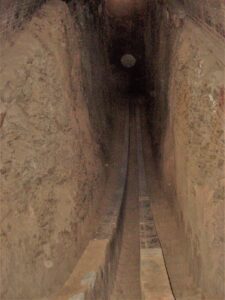SHARE WITH FRIENDS:
The Ulugbek Observatory is one of the rarest examples of 15th-century architecture in Samarkand, an ancient astronomical observatory.
It was built by the order of Ulugbek in 1428-29 on the top of Kohak (Choponota) in the form of a huge cylinder; According to some manuscripts ("Boburnoma"), the score. It is built as a 30,4-storey building of 3 m. It contained more than a dozen different astronomical devices and instruments. The most important of these is the quadrant (or close to the sextant) device, which consists of a double arc with a radius of 40,2 m. Quadrant's jan. part underground, the rest pants. 30 m above the ground. The arc of one degree is 701,85 mm and the minute arc is 11,53 mm. The observatory was also unique in terms of equipment in the Middle Ages. The instrument measured the basic constants of astronomy, such as measuring the angle between the equator and the ecliptic, determining the annual precession constant, the duration of a tropical year, and other fundamental astronomical constants. The observatory was equipped with small instruments: an armor sphere, measuring instruments consisting of 2, 4 and 7 rings, a triangle, a sun and star clock, an astrolabe and others. Using this scientific equipment, the Sun, Moon, planets and individual stars were observed. Mirzo Ulugbek's largest astronomical work "Ziji Koragoniy" was created at the observatory. Its construction and further scientific activity are connected with the names of a number of famous scientists Giyosiddin Kashi, Qazizoda Rumi, Ali Kushchi and others, who came together at the suggestion of Ulugbek.
Archaeological remains of the Ulugbek Observatory were discovered in 1908. It was found as a result of excavations carried out under the direction of VL Vyatkin. In particular, there is a 48-meter-diameter, one-brick circular wall and the remains of a huge main structure with a double arch in the center. It had large halls and various large and small rooms. According to Bobur, the exterior of the Ulugbek Observatory is decorated with tiles and mysterious rivets. The sun, moon, planets and stars were studied with great accuracy using a very large instrument installed inside the observatory. The observatory also had a library. On the inner wall there is an image of the sky, a map of the stars, a globe with mountains, seas and countries. It was later left unattended and destroyed in the 11th century. At present, the largest instrument in the Ulugbek Observatory, the underground part of the square, is 1964 m high. XNUMX y. The Ulugbek Museum was opened near the Ulugbek Observatory. Uzbek and foreign scientists are conducting research on the original appearance, interior and main structure of the Ulugbek Observatory.
uz.wikipedia.org/wiki/Ulug%CA%BBbek_observatory
